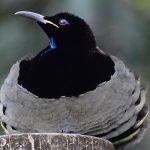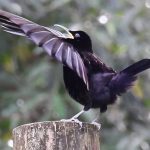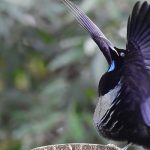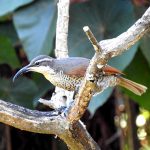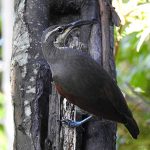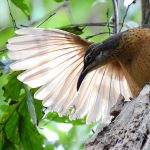PARADISE RIFLEBIRD
Nature’s Iridescent Performer
The Paradise Riflebird is one of Australia’s most captivating avian wonders, celebrated for its dramatic courtship rituals and iridescent beauty. Native to the rainforests of eastern Australia, this species is a distinguished member of the birds-of-paradise family—a living symbol of nature’s artistry and evolutionary creativity.Appearance
Encountering a Paradise Riflebird in its natural habitat is a feast for the senses:
- Male Plumage: Deep, velvet-black feathers set the canvas for brilliant bands of metallic blue-green and purple along the breast, crown and tail. When sunlight hits, these feathers dazzle with a jewel-like brilliance, almost as if the bird is wearing a cloak woven of sapphire and emerald light.
- Size: Measuring approximately 25–30 cm (10–12 inches), the Paradise Riflebird is a medium-sized rainforest dweller.
- Female Plumage: Females lack the male’s spectacle, instead wearing brown and buff patterned feathers, offering excellent camouflage among the forest’s leaf-litter and tree limbs.
Habitat
- Distribution: Found only in Australia, the Paradise Riflebird inhabits subtropical and temperate rainforests from central-eastern Queensland to northern New South Wales.
- Environment: Preferring high, dense canopies, riflebirds thrive where sunlight filters softly through layers of leafy green, the air lingering with earthy scents and the gentle murmurs of distant streams.
Diet and Ecological Role
- Diet: Their menu includes insects, spiders, and a diversity of ripe rainforest fruits.
- Ecological Importance: By foraging on fruit, riflebirds distribute seeds, aiding plant regeneration. Their appetite for insects also helps maintain a balanced forest ecosystem.
Breeding and Family Life
- Timing: Breeding takes place from August to February, aligned with the wetter, more bountiful seasons of the Australian calendar.
Courtship: The Male’s Performance
- During breeding, males fiercely defend and prepare their favoured display perches, meticulously clearing away leaves to create a stage bathed in sunlight.
- The courtship display is an extraordinary performance: the male spreads his wings, curving his body in dramatic arches, repeatedly flashing his iridescent feathers as he emits a sequence of ringing whistles and clicks.
- Mating System: Paradise Riflebirds are polygynous; individual males may display to, and mate with, several females. Females alone select their mate, judging displays with rigorous care.
Nest Building
- Builder: Only the female constructs the nest.
- Nest Site: She selects a well-hidden perch high in the canopy, often shielded by a tangle of branches and leaves.
- Structure: The nest is an open cup woven from sticks, vines and leaves, artfully lined with downy plant fibres for extra warmth and protection.
Eggs and Incubation
- Clutch Size: Usually 1–2 pale, subtly marked eggs per clutch.
- Incubation: The female incubates the eggs alone for about 22 days, relying on her own camouflage for the nest’s safety.
Chick Rearing
- Chicks hatch blind and helpless, wholly dependent on the mother for warmth and nutrition.
- For roughly 16–22 days, she supplies them with a diet of soft insects and fruit, quietly tending to their every need until they fledge (leave the nest).
- Even after fledging, the young may stay under her watchful guidance as they learn to navigate the complex world of the rainforest.
Male’s Role
- After mating, the male’s parental involvement ends; he does not assist in nesting or rearing the young, dedicating his energy solely to attracting future mates through song and display.
Conservation
Though currently listed as Least Concern, the Paradise Riflebird’s future relies on the preservation of unbroken rainforest. As forests are cleared or fragmented for agriculture and development, suitable breeding and feeding habitats disappear, putting pressure on both ancestors and descendants of these spectacular birds. Safeguarding rainforest ecosystems is essential—not only for riflebirds but for all species in these remarkable environments.
The Paradise Riflebird represents not just the brilliance of nature’s palette, but also the intricate, often hidden, cycles of life that fill Australia’s rainforests. From dazzling displays to the gentle act of nest-building, each part of their life story is a reminder of the delicate interdependence between species and their habitats.
By choosing to protect and revere these pristine forests, we help ensure that the Paradise Riflebird’s dance—and the ancient rhythms of Australian wildlife—continue to enchant and inspire for generations.

